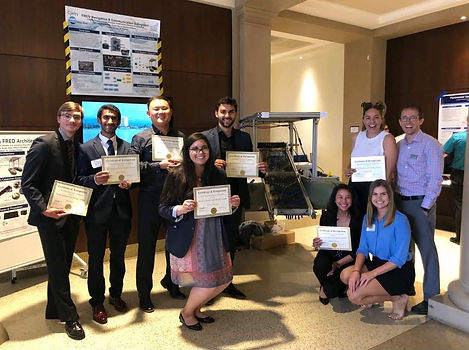miniFRED
FRED: Floating Robot for Eliminating Debris
This was a client based project during my senior year in undergrad, the presentation and video below are the collective materials used to demonstrate the marine drone; miniFRED, I engineered with an 8 person team through August 2018 - 2019 for the nonprofit Clear Blue Sea. Our prototypes first began as two separate projects to two different teams, then later merged as a complete prototype.
Client
Clear Blue Sea
Role
Engineer
Lead Presentation Designer
Team Member(s)
Christiana Salvosa
Iyad Asulaiman
Scott Kolnes
Xiaolong Fu
Zane Deck
Erin Kendrick
Sydney Platt
Lissi Riccio
Year
2018-19
The Problem
There aren't any unmanned vehicles tackling the issue of plastic in the middle of the ocean.
Introduction
Clear Blue Sea is a start up nonprofit organization with the goal of removing plastic debris from the ocean with a Floating Robot for Eliminating Debris (FRED). Though they had mockups of FRED and ideas of it being operable on its own (semiautonomous) they needed our help bringing it to life. My team was tasked with developing a presentable prototype with a robust navigation and communication subsystem in one year.
The Goal
Our goal is bring minFRED to life for Clear Blue Sea to show investors a small version of how they imagine a full scale unmanned robot removing plastic debris from the ocean.

Research
My team and I did extensive research on plastic debris in the ocean; specifically the Great Pacific Garbage Patch. We also looked into current projects that are working on the same issue. One project is Mr. Trash Wheel; Baltimore's harbor cleaner that runs on solar energy.



Problem
After much deliberation and project sprints, we took a step back to re-evaluate our problem we were trying to solve. We considered many ideas but we took our time constraint as well as the needs of Clear Blue Sea into consideration specifically that of semi autonomous navigation and ultimately decided on using open source drone software - it was picking which one that would be our issue.
Early Prototype & Iteration
It was very important to our client that the navigation system was elegant and user-friendly. Thus, we tested an open source drone software; Ardupilot with compatible hardware although this was used for flight we became familiar with the navigation user interface and how telemetry was used as communication. This also made us think about how to power our devices utilizing solar energy.
Our team members, Fu and Iyad became our solar power team and completed research on lithium batteries and solar panels.


USD Clear Blue Sea Testing 2019
Final Prototype
Many iterations and project sprints later I found ArduSub. The navigation and communication was similar to that of Ardupilot since ArduSub fell under the same open source family. Now, we had operable software for thrusters in the open water, this allowed us to merge with Clear Blue Sea's architecture team increasing my team to 8. Iyad and Fu had found a sufficient solar panel that would charge the lithium battery used to power the drone - miniFRED.
Final Presentation
As design lead, I made sure our presentation had the balance between visual aesthetics as well as vital content to demonstrate the progress of our prototype to our shareholders and engineering professors. I used Adobe Photoshop and Google Slides. Below is video footage I filmed and edited to demonstrate testing miniFRED.

that's me!
Professional Gold Medal Award
My team, professor and I celebrating our win for best design, implementation of design and presentation of our marine drone; miniFRED.
(Not all pictured here)
Key take aways
There are many online resources and forums that are havens of innovation. Any questions my team had, we were able to receive prompt responses from forums. Also, breaking down our project into sprints was helpful because it helped my team focus on solving one aspect at a time.

